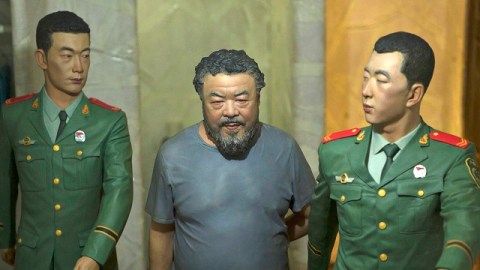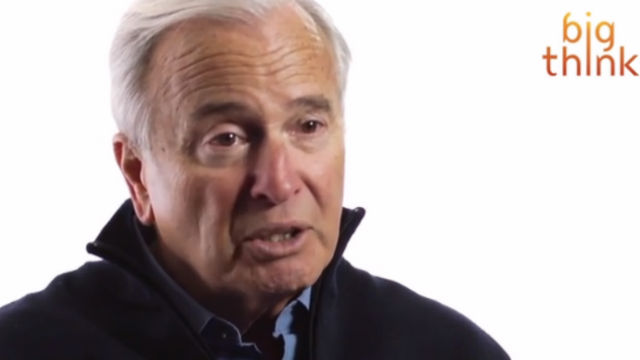Documenting China’s Fake Case Against Ai Weiwei

“You criticize them too much. If this was 1957 they would have killed you already,” Chinese artist Ai Weiwei’s worried mother tells him in a new documentary titled Ai Weiwei: The Fake Case, which documents the Chinese government’s fabricated charges of tax evasion against the Beijing Fake Cultural Development Ltd, a business registered not in his but in his wife’s name, although the charges are leveled against Ai. “It’s a fake case,” Ai explains. “It’s a fake case about a Fake Company. But the Fake Company is a real company and the fake case is a real case, but it’s fake, it’s fabricated.” In this up-is-down world, Danish filmmaker Andreas Johnsen captures the very real day-to-day dangers the artist and those close to him face from a Chinese government that fears Ai’s online influence with a young generation of plugged-in Chinese capable of considering widespread cultural change. More than any documentary on Ai Weiwei so far, Ai Weiwei: The Fake Case depicts accurately what it is to be an artist struggling bravely against political oppression and the personal cost of that fight.
Andreas Johnsen seems the perfect filmmaker for The Fake Case. A self taught filmmaker, Johnsen works almost entirely alone, in many cases filming, directing, producing, and even financing his films, which often center around those, like Ai, who speak truth to power, such as his 2009 film Murder that followed pregnant women in Nicaragua facing possible death if they don’t get an abortion, which is strictly banned under any circumstances in that country. “From my very first trip to China back in 2010 I only imposed one rule on myself: to be with Ai Weiwei as much as possible and to film only when he was present, to see what he sees and hear what he hears,” Johnsen says. “I’ve had close to unlimited access to film his life and I believe this is an expression of his acceptance of my methods and patience and persistence as well as his will to show the world that he has nothing to hide, whatsoever.” It’s amazing not only that Ai allowed his already government-observed life to be intruded upon further by a filmmaker, but also that Johnsen overcame that same government’s watchful eye to make his film. Because the government tracked Ai’s every move outside, Johnsen filmed much of the documentary inside. When Johnsen did follow Ai outside, he had to keep his camera hidden. Johnsen even had to hide his footage in secret locations each day to prevent the Chinese government from seizing it.
The film takes place after Ai Weiwei’s 81-day imprisonment by the Chinese government in early 2011. “They clearly tell you: ‘You cannot have a lawyer, you cannot call your family.’ For six months. That’s kidnapping!” Ai tells Johnsen of his incarceration. Even after his release, Ai is put under house arrest. Johnsen films the artist calling to request permission to go outside. Magnanimously, Weiwei refuses to blame his case officer personally, choosing instead to blame the system they’re both suffering under. Failing to silence Ai by that seizure, the Chinese government charges him with tax evasion to the tune of $2.5 million, which is now known as the “Fake Case” (which Ai and his people have documented thoroughly at his own site). Just to appeal the case, Ai needs to come up with a bond of $1.5 million. Supporters donate the entire amount, in some cases folding bills into paper airplanes and anonymously flying them over the walls around his home. The film ends with the end of Weiwei’s probation period as he finally gets to take the Fake case to court.
Johnsen mingles among those dramatic events the mundane events of Ai Weiwei’s life: washing his face in a sink, swimming with his little boy Ai Lao and his girlfriend, driving around as his son sucks his thumb in the back seat, family pictures on the fridge. It’s these everyday, unnoteworthy touches that make the story so Kafkaesque. Just as Gregor Samsa woke one morning transformed into an insect, Ai awoke one morning transformed into a god of misrule. “It’s strange [the Chinese government] have to turn me into a god,” Ai says wearily. “I’m already miserable, and they just won’t give me a break.” Watching the artist fall asleep even in the middle of a conversation with a fellow artist, you get a sense of how weary he has become of the whole ordeal. Ai Weiwei allows Johnsen to capture his lapses of memory and even confesses to the camera the nightmares that continue from the psychological torture of his time in captivity. As much as we think of Ai Weiwei as the lone voice of resistance from his artwork, publications, and even his Instagram and Twitter accounts, the reality is that he is part of a strong network of friends and family that suffer along with him. It says a lot about the man when the brightest flash of anger at authorities comes not when he is assaulted but when a young friend is manhandled by police in a struggle for a camera.
In the second half of the film we see Ai Weiwei’s multipart sculpture S.A.C.R.E.D. come together. S.A.C.R.E.D. (which stands for “Supper, Accusers, Cleansing, Ritual, Entropy, andDoubt”) recreates in meticulous detail six different scenes from his imprisonment by the Chinese government: eating, sleeping, shitting, walking, interrogating, and showering. (A detail from the walking scene appears above.) In almost every scene as it was during his imprisonment, Chinese police surround Ai’s every waking and even sleeping moment. To punish Ai, the Chinese officials denied him paper to write on and even denied him enough privacy to be alone with his own thoughts and dreams. In the film we see Weiwei describe to the sculptors making the scene of him sleeping in his cell how one officer would sit and stare at him all night while another would pace back and forth to stay awake loudly enough to disturb continually his sleep. That piece eventually made its way to the Venice Biennial to publicize his mistreatment as much as his continued resolve to make art in the face of tyranny. The advertising tagline for the film is “A Life Lived in Silence Is Not a Life,” which rings loudest and truest at this moment of turning evil into art.
Ai Weiwei is very much alive in Ai Weiwei: The Fake Case. Johnsen concludes the film with an extended shot of the artist taking a shower as Nina Simone sings “Feeling Good” loudly and proudly. Simone’s bluesy voice captures perfectly the blues spirit of Ai Weiwei and Johnsen’s documentary. Even when things look their darkest, Ai Weiwei the bluesman never loses his sense of humor. The fact that the Chinese government still charges Ai with pornography because of the joking photograph One Tiger and Eight Breasts proves his continued ability to kid around and their continued ability to just not get it. When Ai Weiwei comically sneaks up behind the spies stationed to watch his every move in the film, he does it with the impish delight of a child. Many Chinese compare refer to Ai as “Divine Comedy” because of his Dante-esque ability not just to create a world through art but also to make his life into art. When Dante used the word “comedy,” he meant a dire situation that ends well—another blues belief system. Like Dante, Ai Weiwei finds himself in a hell right now, but never loses his faith in art, in choosing life and laughter over silence and sadness. In the middle of Ai Weiwei: The Fake Case the artist makes a very real, very possible case that the fall of the secretive Chinese government is inevitable in the face of young generations driven by modern technology’s capacity to share information. If and when Ai Weiwei’s prophesy comes true, we’ll all be feeling good.
[Image: Detail from S.A.C.R.E.D., an artwork by Ai Weiwei.]
[Many thanks to Rosforth and Danish Documentary for providing me with the image above and access to a review copy of Ai Weiwei: The Fake Case, a film by Andreas Johnsen, which will debut in several U.S. cities in May 2014 (see list of theaters here).]





